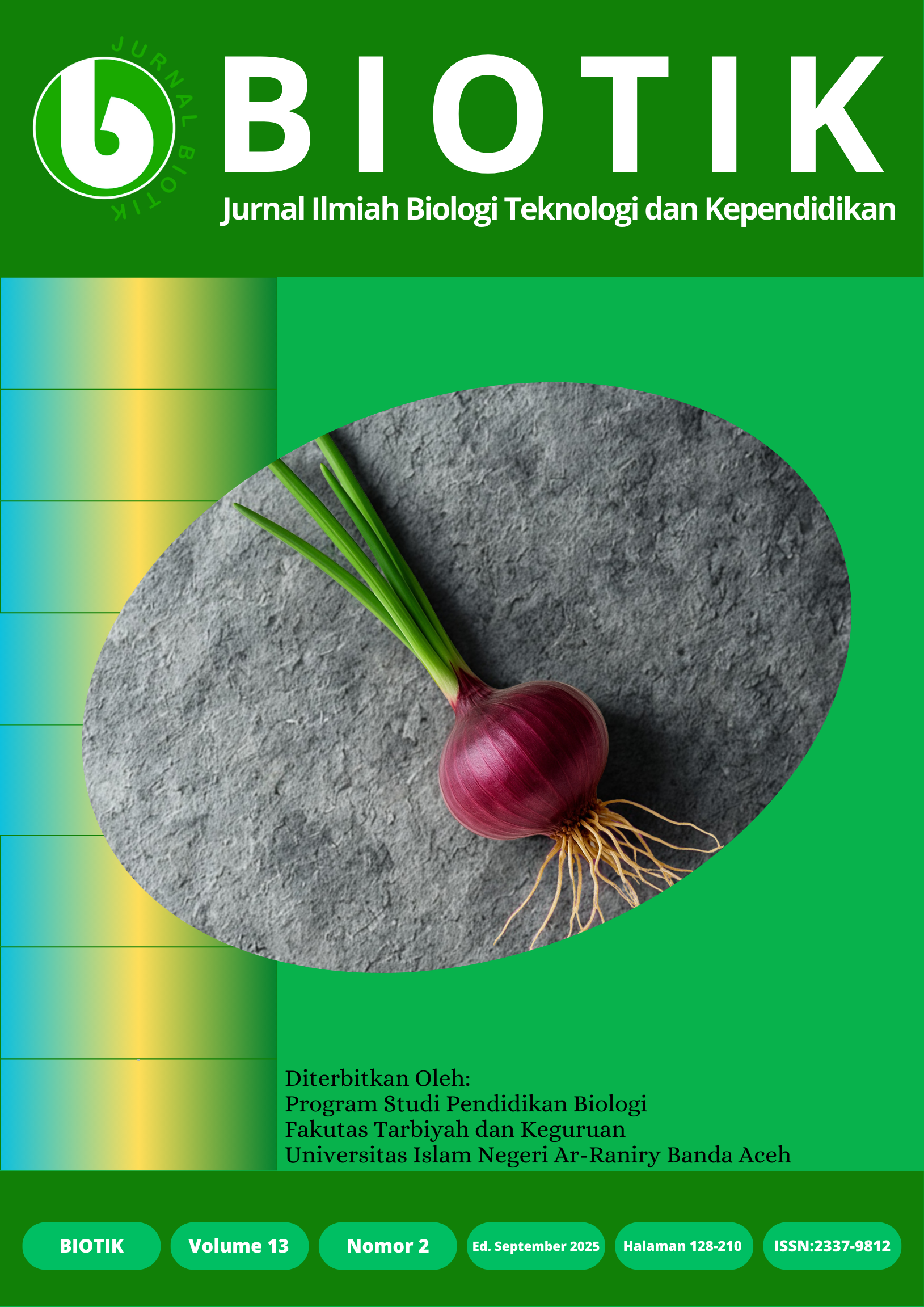Dry Preparation of Trichoderma Species Promotes Significant Decrease of Fusarium oxysporum in Shallot Cultivation (Allium ascalonicum)
DOI:
https://doi.org/10.22373/biotik.v13i2.29398Keywords:
Allium ascalonicum, Fusarium oxysporum, growth, Trichoderma sp., yield.Abstract
Shallot is a horticultural plant that is susceptible to pathogen attacks. The continuous use of non-biological fungicides has a negative impact on the environment, making it necessary to implement biological control using antagonistic microorganisms. This study aims to evaluate the differences in growth and yield of shallots treated with a dry formulation of Trichoderma sp. to control Fusarium wilt. The study was conducted using a Randomized Block Design (RBD) with four treatments and six replications. The concentrations used were 0 grams/liter, 7 grams/liter, 14 grams/liter, and 21 grams/liter. The data analysis results showed that the dry formulation of Trichoderma sp. at a concentration of 21 grams/liter was the most effective in controlling Fusarium wilt, with the lowest disease severity of 23.16 (F_1,24=47.61, p<0.05). It also significantly increased plant height (F_1,24=6.36, 7.89, 14.24, p<0.05), the number of leaves (F_1,24=15.62, 16.07, 18.29, p<0.05), the number of bulbs (F_1,24=13.57, p<0.05), and biomass weight (F_1,24=57.34, p<0.05). The higher the concentration of the dry formulation of Trichoderma sp. applied, the greater the increase in the vegetative and generative growth of shallot plants.Downloads
References
Badan Pusat Statistik, “Produksi Tanaman Sayuran 2021-2023.” Badan Pusat Statistik dan Direktorat Jenderal Hortikultura, 2024.
Pusat Data dan Sistem Informasi Pertanian, Outlook Komoditas Pertanian Subsektor Hortikultura: Bawang Merah. Kementerian Pertanian, 2023.
D. Asih, "Dinamika Agroekosistem Penyakit Moler (Fusarium oxysporum F. Sp. Cepae) Bawang Merah di Sentra Produksi Kabupaten Brebes," M.S. thesis, Program Studi Fitopatologi, Fakultas Pertanian, Institut Pertanian Bogor, Bogor, 2022.
Muliana, Iswahyudi, and B. Juanda, "Pengaruh dosis Trichoderma harzianum dan Varietas Bawang Merah untuk Mengendalikan Penyakit moler (Fusarium oxysporum) dan produksi tanaman bawang merah (Allium ascalonicum L.)," Jurnal Ilmu Pertanian Tirtayasa., vol. 6, no. 2, pp. 377–391, 2024.
Suwahyono, “Cara Membuat dan Petunjuk Penggunaan Biopeptisida.” Jakarta: Penebar Swadaya, 2010.
A. Yasintasari and P. Hadi, "Pengaruh Dosis dan Waktu Pemberian Trichoderma sp. terhadap Fusarium oxysporum pada Bawang Merah (Allium ascalonicum L.)," Jurnal Variabel Pertanian., vol. 15, no. 2, pp. 105–122, 2021.
I. Sudantha, N. Sridanti, and H. Suheri, “Penggunaan Kompos Limbah Pertanian Untuk Pengendalian Penyakit Layu Fusarium pada Tanaman Tomat.” Yogyakarta: Risalah Kongres Nasional XII dan Seminar Ilmiah PFI, 1993.
N. Amaresan, A. Sankaranarayanan, M. K. Dwivedi, and I. S. Druzhinina, “Advances in Trichoderma Biology for Agricultural Applications,” Springer, 2022.
L. Bolero, D. Perrig Masciarelli, O. Penna, C. Cassan, and V. Luna, "Phytohormone production by three strains of Bradyrhizobium japonicum and possible physiological and technological implications," Appl. Microbiol. Biotechnol., vol. 74, pp. 874–880, 2007.
H. Krisnamoorthy, “Plant Growth Substances Including Applications in Agriculture,” Tata McGraw Hill Publishing Co. Ltd., New York, 1981.
F. Salisbury and C. Ross, “Fisiologi Tumbuhan Jilid 1.” Bandung: ITB, 1995.
W. Kusumawardani, H. Kusnayadi, and I. Maesari, "Pertumbuhan dan Hasil Bawang Merah (Allium ascalonicum L) pada Berbagai Jenis Varietas dan Dosis Pupuk Organik Cair," Jurnal Agroteknologi Universitas Samawa., vol. 3, no. 2, pp. 29–38, 2023.
A. Wachid and A. Aziz, "Pengaruh Trichoderma sp. dan Macam Pupuk Kandang Terhadap Pertumbuhan dan Produksi Sawi Hijau (Brassica rapa L.)," Jurnal UMS., vol. 7, no. 1, pp. 1–10, 2019.
B. Lakitan, “Dasar-dasar Fisiologi Tumbuhan.” Jakarta: PT Raja Grafindo Persada, 1993.
Suwahyono, "Trichoderma harzianum indigeneous Untuk Pengendalian Hayati: Studi Dasar Menuju Komersialisasi dalam Panduan Seminar Biologi," presented at Seminar Biologi, Fakultas Biologi UGM, Yogyakarta, 2003.
E. Doo, Y. Kim, and Y. Lee, "Trichoderma as a biological control agent: Mechanisms of action and applications," World J. Microbiol. Biotechnol., vol. 39, no. 5, pp. 123–137, 2023.
I. Subandar, M. Jalil, C. Chairudin, and V. Maulidia, "Pelatihan dan Praktik Pembuatan Trichokompos Berbahan Aktif Trichoderma asperellum* Asal Lahan Gambut di Ujong Tanah Darat, Kecamatan Meureubo, Aceh Barat," Bakti Cendana., vol. 6, no. 2, pp. 112–118, 2023.
Downloads
Published
Issue
Section
License
Copyright (c) 2025 Distira Viro Nika

This work is licensed under a Creative Commons Attribution-ShareAlike 4.0 International License.
Authors who publish with BIOTIK: Jurnal Ilmiah Biologi Teknologi dan Kependidikan agree to the following terms:
- Authors retain copyright and grant the journal right of first publication with the work simultaneously licensed under a Creative Commons Attribution License that allows others to share the work with an acknowledgement of the work's authorship and initial publication in this journal.
- Authors are able to enter into separate, additional contractual arrangements for the non-exclusive distribution of the journal's published version of the work (e.g., post it to an institutional repository or publish it in a book), with an acknowledgement of its initial publication in this journal.
- Authors are permitted and encouraged to post their work online (e.g., in institutional repositories or on their website) prior to and during the submission process, as it can lead to productive exchanges, as well as earlier and greater citation of published work.











